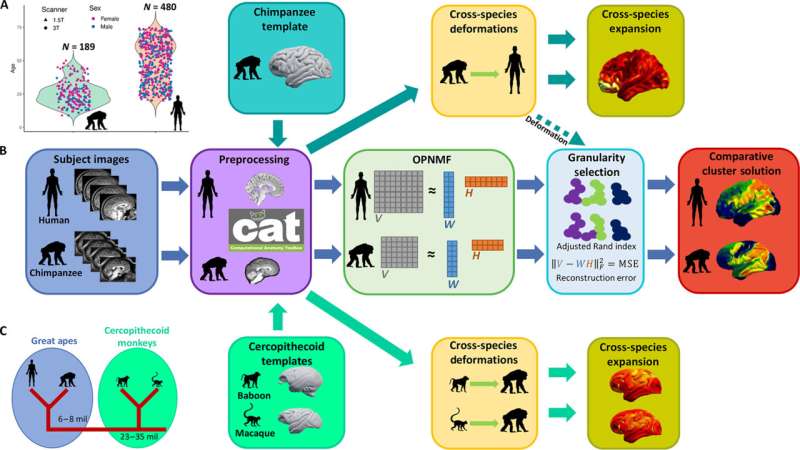August 29, 2024 report
This article has been reviewed according to Science X's editorial process and policies. Editors have highlighted the following attributes while ensuring the content's credibility:
fact-checked
peer-reviewed publication
trusted source
proofread
Brain study suggests regions that grew the most during evolution are most susceptible to aging

An international team of neuroscientists and anthropologists has found that the parts of the brain that grew the most during human evolution are the parts that are now the most susceptible to aging.
In their paper published in the journal Science Advances, the group describes how they studied hundreds of MRI scans of chimps and other apes at differing stages of their aging process and compared them to human MRIs taken at similar times during the human aging process.
Prior research has shown that at some point in history, the human brain began to grow proportionally bigger than that of the other great apes, allowing humans to grow more intelligent. In this new study, the researchers noted that for the human brain to grow as it did, something else had to be sacrificed.
To learn more about the changes that have come about in brain growth between humans and apes, the research team obtained 480 MRI scans for people at different ages. They did the same for 189 chimpanzees and several other apes and monkeys.
They then compared changes in the brain over time between species using a specialized computer program they wrote. They found what they describe as a greater loss of gray matter in humans as they age than occurs with apes and monkeys.
The team noted that prior research has led to evolutionary theories regarding "last-in, first-out," which suggests that traits that develop later on a timeline in a given species are the first to deteriorate as a given individual ages.
In comparing the human brains with the chimp and ape brains, they found that humans do tend to experience more gray matter deterioration (starting at around age 30). They also noted that other research has shown that development of gray matter in the prefrontal cortex is the last to mature.
Taken together, they suggest that the data shows that the increase in brain size in humans was due to an increase in gray matter, most particularly in the orbitofrontal cortex and ventral prefrontal cortex, because that is where the most gray matter is lost during aging.
More information: Sam Vickery et al, The uniqueness of human vulnerability to brain aging in great ape evolution, Science Advances (2024). DOI: 10.1126/sciadv.ado2733
© 2024 Science X Network





















